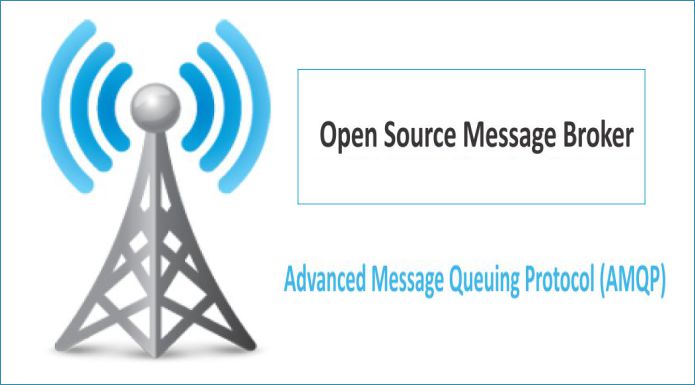
Advanced Message Queuing Protocol (AMQP)
Advanced Message Queuing Protocol (AMQP) is designed as a standard protocol that supports messaging over the middle-wave. AMQP has created a functional method of accord between the middle-ware and the client. This model of support is comprised of a set of components whose function is to route messages from the broker service. It also allows client applications to communicate and interact with the server and the AMQ model through a network live wire. The AMQ protocol is a distribution model, and includes various messaging systems, such as point-to-point, publish, fan-out, subscribe, and request-response. It does not store messages. The messages go to queues.
Open Source Message Broker – AMQP Implementations
There are five top Advanced Message Queuing Protocol (AMQP) implementations available today. These Open Source Message Brokers are explained in detail as follows:
RabbitMQ
The programming language for RabbitMQ is Erlang. ![]() RabbitMQ is simple, straight forward and robust. Most major operating systems and platforms are supported by RabbitMQ. It is under the Mozilla Public License. RabbitMQ is specifically designed for businesses and as well as lightweight web messaging. It can also provide messaging through various adapters, such as SMTP, STOMP, and HTTP. It has many active users and contributors and uses the SprinSoruce division of VMAre to provide a full range of support for businesses. Rabbit MQ does not limit clients to one time messages. It will enable you to send messages to consumers twice and the consumers can get different message at one time. The clustering feature on RabbitMQ is one of the drawbacks. Because two queues need to be set up on two hosts, this means client-side duplication is not possible. It is not able to support scalability of more than 250,000 clients and queues. Failures due to DNS/DHCP are quite common.
RabbitMQ is simple, straight forward and robust. Most major operating systems and platforms are supported by RabbitMQ. It is under the Mozilla Public License. RabbitMQ is specifically designed for businesses and as well as lightweight web messaging. It can also provide messaging through various adapters, such as SMTP, STOMP, and HTTP. It has many active users and contributors and uses the SprinSoruce division of VMAre to provide a full range of support for businesses. Rabbit MQ does not limit clients to one time messages. It will enable you to send messages to consumers twice and the consumers can get different message at one time. The clustering feature on RabbitMQ is one of the drawbacks. Because two queues need to be set up on two hosts, this means client-side duplication is not possible. It is not able to support scalability of more than 250,000 clients and queues. Failures due to DNS/DHCP are quite common.
OpenAMQ
Open AMQ has client libraries available for C / C++ and  JMS. Wire API has remote tools for administration, protection against slow clients, and many additional features provided by C API. The handling of messages, transactions, the replication of exchange, queues, and much more is supported through HA. HA support is aside from federation support, as the server-side state is recreated. There are some disadvantages including fewer documents and the lack of strong community support for the implementation. It is written in Java and doesn’t have the features for other languages. OpenAMQ is a part of AMQP 0.9.
JMS. Wire API has remote tools for administration, protection against slow clients, and many additional features provided by C API. The handling of messages, transactions, the replication of exchange, queues, and much more is supported through HA. HA support is aside from federation support, as the server-side state is recreated. There are some disadvantages including fewer documents and the lack of strong community support for the implementation. It is written in Java and doesn’t have the features for other languages. OpenAMQ is a part of AMQP 0.9.
StormMQ
Middleware from StormMQ is hosted On-Premise or a cloud ![]() solution. The platform is secure and open, and for data transferred through the cloud legal protection is required. StormMQ also operates with clients of RabbitMQ, ApacheQpid and through the Mozilla Public License. The language used is Java, and StormMQ includes some well-known US companies, including the US Department of Energy.
solution. The platform is secure and open, and for data transferred through the cloud legal protection is required. StormMQ also operates with clients of RabbitMQ, ApacheQpid and through the Mozilla Public License. The language used is Java, and StormMQ includes some well-known US companies, including the US Department of Energy.
ApacheQpid
ApacheQpid uses C++, JMS, Java, Python, .Net and Ruby.  Advanced Message Queuing protocol specifications, clustering, support for multiplatform, and security are all implemented by Apache. The nodes, containing the queue data and metadata make up the cluster. Qpid itself is a project of Apache. Apache has many clients, two brokers, a few additional boost libraries and support for C++ and Python. When using the HTTP Gateway this is not possible. Support is provided for persistent queues of undelivered messages, and these survive after a server restart.
Advanced Message Queuing protocol specifications, clustering, support for multiplatform, and security are all implemented by Apache. The nodes, containing the queue data and metadata make up the cluster. Qpid itself is a project of Apache. Apache has many clients, two brokers, a few additional boost libraries and support for C++ and Python. When using the HTTP Gateway this is not possible. Support is provided for persistent queues of undelivered messages, and these survive after a server restart.
Red Hat Enterprise MRG
 This is the latest version of AMQP 0-10 and it has a number of very good features. These include full management, Active – Active clustering through ApacheQpid, federation as well as support for the web console. It is available through the most recent version of Fedora as part of the AMQP infrastructure. It also includes QPID from Apache which has improved the messaging system. This has also provided support for SOA Technology. The IT infrastructure for the next generation of messaging is provided, and it offers better performance, durability, accord, and speedy computing.
This is the latest version of AMQP 0-10 and it has a number of very good features. These include full management, Active – Active clustering through ApacheQpid, federation as well as support for the web console. It is available through the most recent version of Fedora as part of the AMQP infrastructure. It also includes QPID from Apache which has improved the messaging system. This has also provided support for SOA Technology. The IT infrastructure for the next generation of messaging is provided, and it offers better performance, durability, accord, and speedy computing.
It will support large files, and will cycle and parallel harvest scheduling. It offers high performance and worldwide management is distributed. The real time grid is set at over 50 RPMS.
Summary
Advanced Message Queuing Protocol – AMQP’s main purpose is to deliver messages. It needs to have a simple queue system and be able to get asynchronous messages delivered. It needs to be simple to use and implement. Durability is essential as is scalability. RabbitMQ is one of the best and widely used open-source message brokers. Message broker comparison will also help you decide the best message broker for your requirements.
